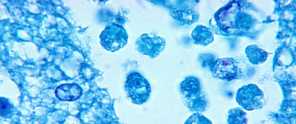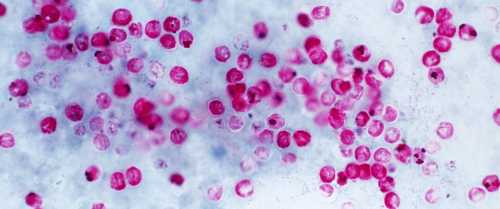Brain-Easting Amoeba enters through nose in freshwater
Something to think about when whitewater rafting:
A young woman died this week in Ohio after being infected by Naegleria fowleri, commonly called a brain-eating amoeba.
Officials from the Franklin County Public Health Department confirmed that the 18-year-old died from amoebic meningoencephalitis, in which the membrane around the brain and spinal cord swells because of infection by the amoeba.
The Franklin County resident was on a whitewater rafting trip in North Carolina when, officials believe, she was infected. She dies on Sunday. Naegleria fowleri is a naturally occurring organism that lives in freshwater throughout the United States. While harmless if ingested, the amoebas can be fatal if they travel through the nasal cavity to the brain.
"The deceased’s only known underwater exposure was believed to be when riding in a raft with several others that overturned at the U.S. National Whitewater Center in Charlotte," according to a statement from the North Carolina Department of Health and Human Services.
While getting infected from parisitic amoebas is pretty rare - 0 to 8 infections in the USA each year, nearly all are fatal, according to the U.S. Centers for Disease Control and Preventions (CDC). In the U.S. between 1963 and 2013, 3 out of 132 people managed to survive the infection, according to the CDC. (via "Junior Olympian Teen Fights for His Life After Suspected Infection With Brain-Eating Amoeba")
Their advice is to take steps to avoid getting water up your nose in freshwater lakes and streams, keep your head above water, use a nose clip, or hold your nose shut when underwater.
People can also get infected by using contaminated tap water in a sinus-rinsing device, like the Netty pot which has been featured on Dr. Oz's md show many times and applauded as a good idea. The CDC advises to filter or boil water before using it in such devices.
Symptoms of brain-eating amoeba: Can starrt 1 to 9 days (with a median of 5 days) after swimming or other nasal exposure to Naegleria-containing water and possibly die 1 to 18 days (with a median of 5 days) after symptoms begin. There is no known cure.
Dr. William Schaffner, an infectious-disease expert at Vanderbilt University Medical Center in Nashville, Tennessee, said in an interview last summer that officials can't screen all bodies of water for the organism.
"The amoebas are in small numbers everywhere," he said. "They go hibernate in the wintertime. They’re part of the natural environment."



 Report a concern
Report a concern

 Add Comment
Add Comment



New Orleans Water Flushed for Brain-Eating Amoeba
Brain Eating Amoeba Kills 4-Year-Old Boy
Girl Recovering from Brain-Eating Amoeba Learns to Love Water Again
August 30, 2015, "Houston boy, 14, dies after battle with brain amoeba", http://www.cbsnews.com/news/michael-riley-jr-14-dies-after-battle-with-brain-amoeba-in-texas/
HOUSTON - A 14-year-old boy has passed away after coming into contact with a rare amoeba while swimming in a lake north of Houston.
Relatives said in a Facebook post late Saturday evening that Michael Riley Jr.succumbed to the ravages of the brain-eating amoeba.
Brain-eating amoeba: How to stay safe from Naegleria fowleri
"The tests tonight produced undesirable results which were coupled with the inability to function without support and proper blood flow to the brain," their statement read.
Riley developed a headache and fever, and later became disoriented, after swimming with friends Aug. 13.
In online postings, Michael's family said he had Primary Amebic Meningoencephalitis. The disease usually occurs when the Naegleria fowleri amoeba enters the body through the nose and attacks cells in the brain. The infection causes the brain to swell.
The Centers for Disease Control and Prevention says from 2005 to 2014 the amoeba infected 35 people in the U.S. All but two cases were fatal. A swimmer died of the disease in Oklahoma earlier this month.
While Riley's condition was rare, the amoeba typically lives in warm freshwater and can be found in lakes in the Houston area. It cannot be contracted by drinking contaminated water, only by inhaling it up the nose. To reduce the risk, experts advise keeping your head above water or using nose plugs when you swim in lakes or rivers.
"CHARLOTTE, N.C. – Levels of the brain-eating amoeba Naegleria fowleri that killed an Ohio teen were unusually high in water samples taken from the U.S. National Whitewater Center, and were likely caused by the failure of the water sanitation system, the Centers for Disease Control and Prevention announced this week.
All 11 samples from the white water area of the park tested positive for the potentially fatal organism, the CDC said. Other samples from the nearby Catawba River were negative, although the amoeba was found in one sample of riverbank sentiment.
“Our findings here are significant,” said Dr. Jennifer Cope, an infectious disease physician at the CDC. “We saw multiple positive samples at levels we’ve not previously seen in environmental samples.”
The amoeba were likely able to grow to such concentrations because of the amount of dirt and debris in the water, which turned the water “turbid” or murky, and interfered with the effectiveness of the sanitation process, Cope said.
“When you add chlorine to water like that the chlorine reacts with all that debris and is automatically consumed,” explained Cope. “It is no longer present to inactivate a pathogen like Naegleria.”
Cope said the same is true about the UV light sanitation system at the water park. “If you’re passing turbid water through UV light, the rays cannot inactivate pathogens,” she said.
...
It’s also one of only three such systems in the U.S. that are not required to be regularly tested for pathogens, said Cope. According to local health officials, that’s because it’s viewed as more of a river, even though the park is made of concrete channels that recirculate 12 million gallons of water from the city’s municipal water system, some water wells, and rain.
“They [the center] were not required to be a regulated facility, but that is being questioned for the future,” said Mecklenburg County Medical Director Dr. Stephen Keener in a press conference.
“We don’t know very much about how Naegleria lives and grows in systems like this,” said Keener, “but factors such as soil runoff, uneven surfaces, stones on the bottom where slime can grow, along with shallow channels that allow water to warm quickly on hot days, makes it a unique environment.”
“There will be challenging conversations ahead with various experts in aquatic sector and environmental engineers,” agreed Cope,” about the best ways to address the situation.”...
http://wtkr.com/2016/07/03/brain-eating-amoeba-found-at-unusually-high-levels-at-north-carolina-water-park/